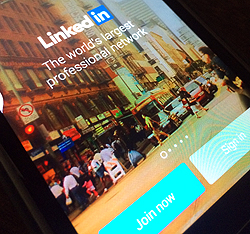4 Steps to Effective Networking on LinkedIn
 With 259 million members, LinkedIn is the leading professional networking site.
With 259 million members, LinkedIn is the leading professional networking site.
It used to be that the sole way for busy professionals to connect involved hustling at networking events – donning nametags and making forced introductions over brunch buffets and stale coffee. Anyone who’s attended these events, often hosted by local business associations, can tell you that many eat up valuable time while producing few valuable connections.
This all changed with the advent of social media. Today, it’s as likely you’ll meet a prospective partner, vendor or client for the first time through posts, likes and comments. All from the comfort of your office chair. And a vast majority of this virtual schmoozing happens on a single site: LinkedIn.
But LinkedIn is a job-seeking site, right? Not anymore. With 259 million members, LinkedIn is has evolved into an indispensable networking tool for business professionals in every industry.
LinkedIn membership is significantly higher than competing sites like Viadeo (55 million) and XING (10 million). And LinkedIn understood the value of this massive database early on. Besides its traditional job-seeking function, it’s branched out to become a central hub where professionals can trade insights, plan meetings and plant the seeds for real-world business relationships.
If you haven’t begun to leverage this powerful network already, here are four steps to get started.
Step 1: Conduct Searches & Research Profiles
On LinkedIn, there are several marketing tools to take advantage of that can help build a business. To get started, use the Advance LinkedIn Search Function and filters. A search for related industry players and prospects can quickly yield a list of people and businesses worth connecting with.
But you’ll still have to do a bit of digging. Browse through the profiles to learn more in-depth information about a company’s niche and needs, or a person’s area of focus. Follow those that most closely align with your business goals, and it could lead to invitations to connect offline.
Step 2: Join Group Discussions and the Influencer Publishing Platform
Join one of the thousands of groups to engage in discussions with business leaders and thinkers. These groups are typically arranged around a particular industry or profession, and members flock there to both dispense and soak up practical business advice. Asking thoughtful questions and or supplying helpful content in specific discussions establishes your authority while creating familiarity with new contacts.
Just recently, LinkedIn opened up its Influencers Publishing Platform to 25,000 members and will roll it out to the entire membership over the next several months. In the past, this platform only allowed a handful of influencers selected by LinkedIn to contribute blogs. Now it allows all of its members to blog on important topics to the whole network – original content that’s also added to their professional profiles. Any LinkedIn professional can share expertise with the entire LinkedIn network and develop a following across the entire site.
According to LinkedIn: “The average Influencer post drives more than 31,000 views and receives more than 250 likes and 80 comments. By any measure, this is a remarkably high level of engagement for digital content.”
Step 3: Brand Your LinkedIn Profile
Obviously, the posts and the name you make in group discussions can lead considerable traffic to your LinkedIn Profile page. So your profile should illustrate a clear brand message, as well as information on the people who run the business. Include all links to your business website here, plus a header image that mirrors your wider branding. (Note: This is strictly a professional site and content and photography should reflect this as well.)
Step 4: Track the Competition
While you’re busy making allies, don’t forget to keep an eye on your competitors. They’re active in this space, too, searching for the same valuable connections and intel. Use LinkedIn as a way to check in on them: their blog posts, their new hires, the new initiatives they’re touting and their opinions on industry trends. It’s a simple way to learn more about the people, direction and branding strategies of your competitors.
You can spend vast amounts of time researching companies and contacts on LinkedIn to better understand your industry. Use it to lob questions, build leads or get a look-see on the competition – but remember, all social media can become a time suck if you let it. Schedule this virtual networking the same way you would any other marketing activity, and follow up with real-world action and face-to-face meetings.
Maybe even a brunch buffet and a cup of coffee or two.